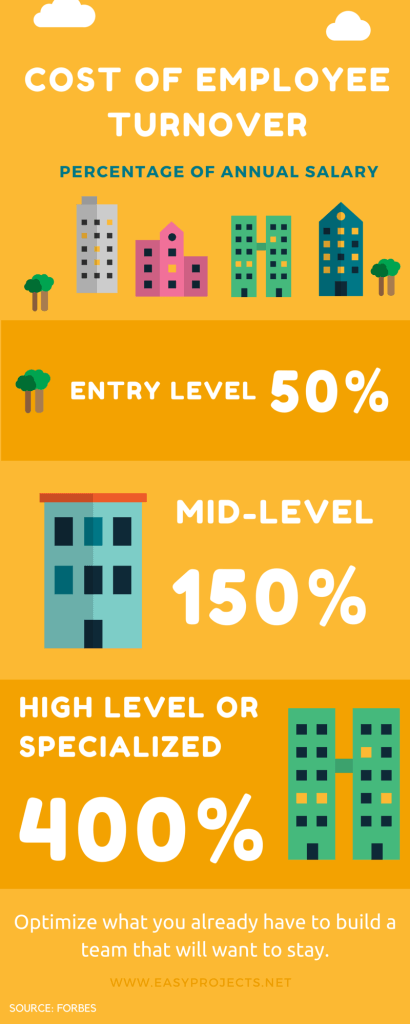Employees leave. It′s a reality businesses have to deal with. While mediocre managers wish on their idols that employees stay forever, the competent ones face this challenge head on.
You might be in slight state of panic thinking about how to deal with all the turmoil that follows after an employee resigns but you should never let this feeling overtake the fact that your company is still running and your task is to manage your marketing team. Management is about strategy. Failing to see the big picture screams incompetence–and soon, it will reflect in your work.
First thing when an employee leaves: accept it. Creative fields are a high turnover industry–with experts even noting an ‘exodus of talent.′ If you′re unable to keep calm and move on, maybe management is not really for you.
Now, you′re ready to hear great managers′ best practices in safeguarding their operations from the impacts of employee turnover.
Read closely and learn from the experts.
1. Exit interviews are a goldmine of management information.
A lot of management professionals downplay the importance of the exit interview. Some even use it to spite the employee for choosing to leave. If you′re any good at management, you′ll know that exit interviews are a useful tool for learning about the strengths and weaknesses of the management and the organization. It should tremendously help in understanding how best to retain employees and drive productivity up.
Here are the important areas to explore during the interview:
- Reasons for leaving.
- Company operations, including policies and employee compensation.
- Job satisfaction.
- Employee support and resources.
Remember, the takeaway from an exit interview should include:
- Company strengths and points for improvement
- Confirmation of the skills and experience needed for the job.
- Insider tips, contacts, best practices from the employee
- Clear understanding of the reasons for leaving
- Parting with employee on good terms
At the end of the interview, make sure you know what the exiting employee knows.
2. Even if the employee is leaving on good terms, make sure he or she is locked out.
While you may lean towards giving an exiting employee the benefit of the doubt, the risks involved in not locking out are just too huge for you to gamble. When an employee leaves, only the most confidential information is protected by common law.
Do you really want to compromise the security of your company and your clients?
When an employee hits the road, get the IT department involved. Locking them out of company systems is much more than asking for their key card, corporate phone and computer back. Here′s a checklist:
- Change all passwords on their personal company accounts
- Change all passwords on all shared usernames they had access to.
- Reset all software and hardware permissions.
- Delete all authentication credentials on all networks they had access to
- Other security measures
The Economist reported that best practice is to implement a two-factor authentication system that will give a solid layer of protection to secure company information always.
3. If you′re not using project management software, you′re gonna have a bad time.
Good managers take advantage of project management software systems to keep track of their employees′ productivity and work behavior. Great managers, however, understand that the software won′t cease to be useful when an employee decides to leave.
There are various software available in the market, but your organization should use one that keeps all project-related information in a central system, logs in a complete history of all client communication, files, work progress, memos and notes. According to the Harvard Business Review, when you have access to this level of information in a single collated source, it is easy for you to see the relationship between performance and the reasons that the employee left.
Most importantly, this information is essential for the next step: finding the replacement. The data from the software will help you find someone who can perform the work that is left vacant–whether the successor be an internal hire or a new recruit. Having the records available to the new guy will result to a smoother transition.
4. Employees will leave–keep that at the back of your mind.
This has to be said again. Know, always, that people leave organizations for different reasons. Although this is a reality that managers face, it also needs to be an effective motivation for better management.
Here′s the truth: employee turnover is expensive! Let′s crunch the numbers:
If you keep in mind that keeping employees is always more financially sound than replacing them, your management will be geared toward optimizing what you already have. Employees are a prized component of your operations–your task is to keep them engaged and motivated to prevent incurring losses due to employee retention problems.
5. Wish them the best even when they′re leaving.
Losing an employee is tough, especially the competent ones. But in the end, it′s all part of business. No matter how everything panned out, always part with employees in good terms–even offer to be a future reference if the situation permits. Let the employee know the organization is appreciative of the contributions made while they were there. There′s no need for tension in this process and the best way moving forward is to wish them the best.
Follow us



